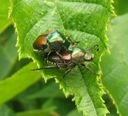Japanese Beetle
Popillia japonica
Classification
- Phylum: Arthropoda
- Subphylum: Hexapoda
- Class: Insecta
- Order: Coleoptera
- Suborder: Polyphaga
- Superfamily: Scarabaeoidea
- Family: Scarabaeidae
- Subfamily: Rutelinae
- Tribe: Anomalini
- Genus: Popillia
- Species: japonica
Pronunciation
How to pronounce Popillia japonica: /pɒˈpɪli.ə ʤəˈpɒnɪkə/
These audio files are automatically generated. While they are not always 100% accurate, they are a good starting point.
Images






Summary
Popillia japonica, or the Japanese beetle, is a scarab beetle known for causing significant damage to a wide range of plants in North America, though it is native to Japan and typically kept in check by natural predators there. Its life cycle includes damaging larval stages that feed on roots and adults that skeletonize leaves and feed on various fruits and flowers.
Physical Characteristics
Adult P. japonica measure 15 mm (0.6 in) in length and 10 mm (0.4 in) in width, with iridescent copper-colored elytra and green thorax and head. A row of white tufts (spots) of hair project from under the wing covers on each side of the body. Males are slightly smaller than females. Grubs are white and lie in curled positions, with a mature grub roughly 1 inch (2.5 cm) long.
Habitat
Commonly found in a variety of habitats, including lawns and gardens where it can access roots of grasses and foliage for feeding.
Distribution
Native to Japan, invasive in North America and Europe. First recorded in the USA in 1916 near Riverton, New Jersey. Detected in most of the continental USA with a few states considered free of the species as of 2015.
Diet
Adults feed on more than 350 different species of plants, especially fond of roses, grapes, smartweed, soybeans, corn silks, flowers, and overripe fruit. The larvae feed on roots of grasses.
Life Cycle
Eggs are laid near the soil surface and hatch within approximately two weeks. Larvae mature into c-shaped grubs, consuming roots and then hibernate in small cells in the soil. The larvae emerge in spring and pupate within 4-6 weeks. Adults have a lifespan of 30-45 days.
Reproduction
Adult females lay eggs in soil from June through early fall, producing 40-60 eggs over their lifetime.
Predators
Parasitized by the introduced fly Istocheta aldrichi and wasp Tiphia vernalis, as well as native species like Scolia dubia. Also affected by introduced species like Campsomeris annulata.
Ecosystem Role
In its native range, natural predators keep the population in check; in North America, it is a notable pest of many plants.
Economic Impact
Considered a pest in North America, damaging a variety of crops and ornamental plants, leading to economic costs for farmers and gardeners.
Collecting Methods
- Traps baited with floral scent or pheromone (though they do not capture efficiently)
- Manual removal from plants if numbers are small
Misconceptions
Though it is a pest in North America, it is not considered one in its native Japan due to natural predators.
Tags
- Japanese Beetle
- Invasive Species
- Scarabaeoidea